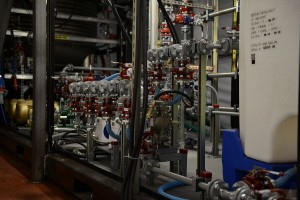Destruction of Syria’s Chemical Weapons-Related Materials Completed Weeks Ahead of Schedule

One of the two Field Deployable Hydrolysis Systems installed on the Cape Ray. I’ll take the value of that over a crate of MANPADS any day. (US Army photo)
As militarized local police riot in Ferguson, Missouri, Iraq continues its meltdown and Afghanistan can’t even agree on how to recount votes, the world has been overdue for the tiniest morsel of good news. Good news is what we got yesterday out of the situation regarding the destruction of chemical weapons-related materials from Syria:
The United States said Monday that it had completed the destruction of the deadliest chemical weapons in Syria’s arsenal, a rare foreign policy achievement for President Obama at a time when the Middle East is embroiled in violence and political turmoil.
/snip/
On Monday, Mr. Obama said that the destruction of the weapons, several weeks ahead of schedule, “advances our collective goal to ensure that the Assad regime cannot use its chemical arsenal against the Syrian people and sends a clear message that the use of these abhorrent weapons has consequences and will not be tolerated by the international community.”
The Organization for the Prohibition of Chemical Weapons provided more details in a press release from their Director-General, Ahmet Üzümcü:
The Cape Ray’s consignment included the most dangerous chemicals in Syria’s arsenal: 581 metric tonnes of DF [methylphosphonyl difluoride], a binary precursor for sarin gas, and 19.8 metric tonnes of ready-to-use sulfur mustard (HD). They were neutralised with two Field Deployable Hydrolysis Systems (FDHS) on the Cape Ray, which reduced their toxicity by 99.9 percent in line with the requirements of the Chemical Weapons Convention.
Furthermore, the operation was successfully completed weeks ahead of the 60-day schedule the U.S. had estimated would be needed, and OPCW inspectors aboard the ship verified that no chemicals of any kind escaped into the sea or otherwise impacted the environment. The Cape Ray will now transport the effluent from the hydrolysis operations to Finland and Germany, where it will be offloaded for disposal at land-based facilities.
Recall that the initial US response to the chemical weapons attacks of August, 2013 in Syria was supposed to be missile strikes and a ramping up of support for “moderate” rebels fighting Assad. But John Kerry achieved some accidental diplomacy and Assad agreed to hand over his chemical arsenal for destruction. Since then, war hawks have been castigating Obama for the very low level of support for Syrian rebels despite the fact that US air strikes in Iraq are now aimed at destroying major weaponry that the US provided to Iraq’s army before it melted away in the face of opposition.
There now is substantial evidence to support the decision not to provide increased support for the moderates, as many of these moderate groups have now shifted their alliance directly into IS support. This terrific Monkey Cage blog post written by Marc Lynch and hosted at the Washington Post, provides very good background on the shifting alliances among the rebel groups: Read more →
